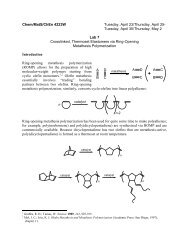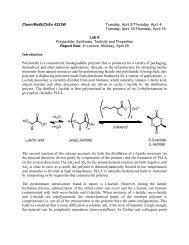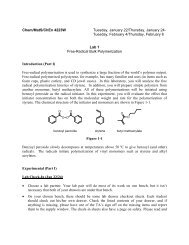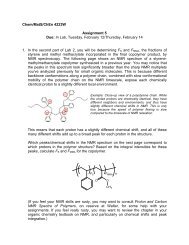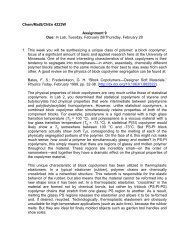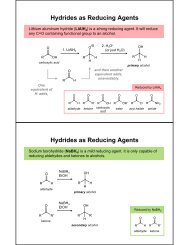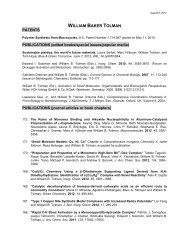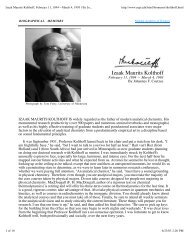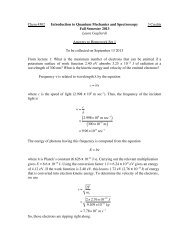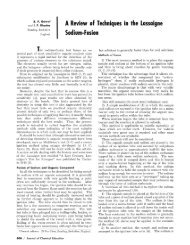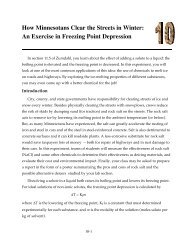Inverse Opal Photonic Crystals - Department of Chemistry ...
Inverse Opal Photonic Crystals - Department of Chemistry ...
Inverse Opal Photonic Crystals - Department of Chemistry ...
Create successful ePaper yourself
Turn your PDF publications into a flip-book with our unique Google optimized e-Paper software.
D. <strong>Inverse</strong> opals<br />
The second part <strong>of</strong> the lab exercise also involves the creation <strong>of</strong> inverse opals, which are inverse<br />
replicas <strong>of</strong> opals. Instead <strong>of</strong> consisting <strong>of</strong> a regular arrangement <strong>of</strong> uniform spherical particles<br />
(as in opals), inverse opals consist <strong>of</strong> a regular arrangement <strong>of</strong> spherical void spaces surrounded<br />
by solid walls. The inverse opals are made after solidification <strong>of</strong> the sol in the void spaces <strong>of</strong> the<br />
synthetic PMMA opals (as described above), by removing the PMMA template to leave a threedimensionally<br />
ordered porous solid. 3,4 An SEM image <strong>of</strong> inverse opal silica is given in Figure 6.<br />
Figure 6. A scanning electron microscopy image <strong>of</strong> inverse opal silica illustrating a close-packed arrangement <strong>of</strong><br />
pores. The white regions are walls around the top layer <strong>of</strong> pores, the gray regions are walls around the second layer<br />
<strong>of</strong> pores, and the black regions are windows connecting the pores.<br />
In addition to the silica inverse opals made in this lab exercise, many other compositions <strong>of</strong><br />
inverse opals can be made, including metal oxides, metals, semiconductors, and others. 5 The<br />
motivation for making inverse opals includes their use in catalysis, sorption, chromatography,<br />
battery materials, and as bioactive materials – uses that benefit from the highly accessible<br />
surfaces and relatively large pore sizes <strong>of</strong> these materials. 5 In addition, the ordered arrangement<br />
<strong>of</strong> the pore structure leads to diffraction <strong>of</strong> light in a manner similar to the diffraction observed<br />
with opals. These diffraction effects endow inverse opals with optical and photonic crystal<br />
properties that may be utilized for optical sensors and circuits, and to guide light waves.<br />
The term “photonic crystal” is used to describe a material with a uniform repetition <strong>of</strong> low and<br />
high refractive index areas. 6,7 <strong>Inverse</strong> opals fit this definition, as they have a uniform<br />
arrangement <strong>of</strong> void spaces containing air (with a low refractive index <strong>of</strong> 1.000) and solid walls<br />
(with a higher refractive index, e.g. 1.455 for silica). A peculiar property <strong>of</strong> these materials is<br />
their ability to “filter” light. When white light, which contains all visible colors <strong>of</strong> light, is<br />
shined on a photonic crystal, some wavelengths are forbidden from passing through the material,<br />
being reflected instead (Figure 7). The remaining wavelengths are unaffected by the photonic<br />
crystal, and they simply pass through. For complete reflection, the refractive index <strong>of</strong> the wall<br />
material must exceed a value <strong>of</strong> 2.8. Significant reflection can be observed, however, even for<br />
lower values <strong>of</strong> the refractive index.<br />
11



